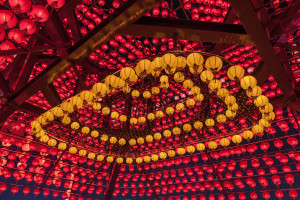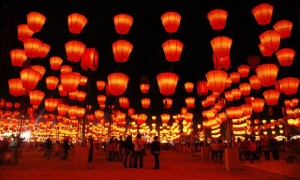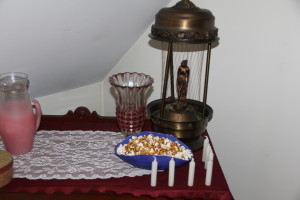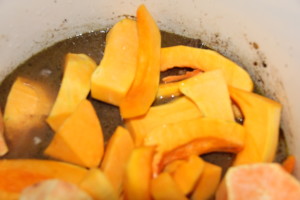 The liturgical season of Lent is now underway having begun on Ash Wednesday which this year fell of February 10th. It is a time of year when Christians of many denominations are called to examine their conscious, fast, pray and perform acts of charity above and beyond what they would normally do the rest of the year. It is a time of cleansing, atonement and purification of the mind, body and especially soul. It is also a time to refrain from activities that distract us from spiritual matters. In Haiti and New Orleans, practitioners of Voodoo often refrain from undertaking any spiritual workings that are not completely necessary. Going through Lent is not particularly fun, but at the end of this forty day period I always feel renewed and more spiritually and mentally clear. It is curious to note that periods of fasting and reflection exist in many cultures and religions throughout the world. In today’s post, we will examine how fasting is observed in different spiritual traditions and the purpose it serves.
The liturgical season of Lent is now underway having begun on Ash Wednesday which this year fell of February 10th. It is a time of year when Christians of many denominations are called to examine their conscious, fast, pray and perform acts of charity above and beyond what they would normally do the rest of the year. It is a time of cleansing, atonement and purification of the mind, body and especially soul. It is also a time to refrain from activities that distract us from spiritual matters. In Haiti and New Orleans, practitioners of Voodoo often refrain from undertaking any spiritual workings that are not completely necessary. Going through Lent is not particularly fun, but at the end of this forty day period I always feel renewed and more spiritually and mentally clear. It is curious to note that periods of fasting and reflection exist in many cultures and religions throughout the world. In today’s post, we will examine how fasting is observed in different spiritual traditions and the purpose it serves.
 Many world religions observe periods of fasting throughout the year and before special events in one’s life. The purpose of fasting is simple, the observation of a strict set of dietary laws and restrictions and the hunger that it might bring, remind us to keep our mind on spiritual matters rather this indulging in food and the pleasures of the world around us. Also, fasting with other believers in a particular faith creates a sense of community and solidarity. In order for fasting to be spiritually beneficial, it must be accompanied by prayers, spiritual introspection and ideally acts of charity. People often assume fasting to be not taking in any food or water at all for any given period of time, but this is only one form of fasting. Such strict fasting is observed in Judaism, the oldest of the Abrahamic religions, on Yom Kippur, the Day of Atonement in which people are called to make amends and atone for past sins in order to have their names written in the Book of Life. According to Jewish tradition, the fates of an individual for the following year are inscribed in Heaven in the Book of Life on Rosh Hashanah, the Jewish New Year which proceeds Yon Kippur but ten days. During this period, people have time to repent and make amends for past misdeeds and if their repentance is sincere, they will received a more favorable verdict on Yom Kippur and have their names transcribed in the Book of Life if they are not already there. So, on Yom Kippur to show contrition and repentance, observant Jews abstain from all food and drink for an entire day and pray fervently. Ashkenazi Jews often fast the day before their weddings, which are seen as a personal Yom Kippur and new beginning for the bride and groom. In Islam, similar strict fasting is observed during the month of Ramadan during which Muslims abstain from all food and drink from sunrise until sunset and break the fast in the evening amongst family and friends. Ramadan is also a time to increase charitable donations and study the Koran more in depth.
Many world religions observe periods of fasting throughout the year and before special events in one’s life. The purpose of fasting is simple, the observation of a strict set of dietary laws and restrictions and the hunger that it might bring, remind us to keep our mind on spiritual matters rather this indulging in food and the pleasures of the world around us. Also, fasting with other believers in a particular faith creates a sense of community and solidarity. In order for fasting to be spiritually beneficial, it must be accompanied by prayers, spiritual introspection and ideally acts of charity. People often assume fasting to be not taking in any food or water at all for any given period of time, but this is only one form of fasting. Such strict fasting is observed in Judaism, the oldest of the Abrahamic religions, on Yom Kippur, the Day of Atonement in which people are called to make amends and atone for past sins in order to have their names written in the Book of Life. According to Jewish tradition, the fates of an individual for the following year are inscribed in Heaven in the Book of Life on Rosh Hashanah, the Jewish New Year which proceeds Yon Kippur but ten days. During this period, people have time to repent and make amends for past misdeeds and if their repentance is sincere, they will received a more favorable verdict on Yom Kippur and have their names transcribed in the Book of Life if they are not already there. So, on Yom Kippur to show contrition and repentance, observant Jews abstain from all food and drink for an entire day and pray fervently. Ashkenazi Jews often fast the day before their weddings, which are seen as a personal Yom Kippur and new beginning for the bride and groom. In Islam, similar strict fasting is observed during the month of Ramadan during which Muslims abstain from all food and drink from sunrise until sunset and break the fast in the evening amongst family and friends. Ramadan is also a time to increase charitable donations and study the Koran more in depth.
As a practicing Roman Catholic, I am most familiar with the fasting practices of Christianity. Fasting as a means of repentance and focusing one’s attention of spiritual matters appears many places in the Bible in both the Old and New Testaments. In preparation for his ministry, Jesus went into the desert and fasted for forty days from which is derived the liturgical season of Lent in preparation for Easter. Christian fasting practices have varied throughout the ages, but today the Lenten guidelines of the Catholic Church are to abstain from meat on all Fridays of Lent and to eat only one full meal on Ash Wednesday and Good Friday. If fasting is too difficult, it is acceptable to substitute prayers or another pious devotion for fasting. In centuries past, fasting rules were much more rigorous and the consumption of all meat and dairy products were forbidden throughout the entire season of Lent. Such is still the practice in the Eastern Orthodox Churches and Eastern Rite Catholic Churches. Eastern churches also observe fasting at other times normally for several weeks before major feast days such as Christmas, The Assumption of the Blessed Virgin Mary and on every Wednesday and Friday throughout the year. Many Protestant denominations leave fasting up to the individual’s conscious rather than assigning specific days for this practice. In recent years, the Daniel Fast has become quite popular. This is a practice based on the Book of Daniel in the Bible in which several young men are taken from Judah and held captive in Babylon and they instruct their captors that they will only eat fruits and vegetables and drink water in order to avoid breaking any Jewish dietary laws. At the end of a prolonged period, it was clear that these captives were healthier than those who had eaten the same diet as the Babylonians. Many people treat the Daniel Fast as a way to lose some weight, but fasting is a spiritual exercise and amounts to little more than a diet if not accompanied by prayers and acts of charity. I personally keep a vegan fast during Lent and try to attended church services an extra day during the week as well as make a donation to charity.
In addition to the major world religions that we’ve mentioned, I know many Wiccans and practitioners of different Pagan religions who often fast before major holidays and before undertaking certain rituals and they report that as a result of a period of fasting and meditation, their powers increase along with the clarity of their psychic vision. No matter what form of fasting we choose to undertake, it’s important to remember that the purpose of fasting is to cleanse ourselves spiritually and to keep our minds focused on spiritual matters. Above all else fasting periods are also times to perform acts of charity and be especially kind to others.
I hope you have found this post interesting and informative and I thank you for taking the time to visit my blog. As always, I wish you peace, blessings and happiness!
Chinese Lantern Festival
 One February morning many years ago, I walked into my first grade classroom to find it decked out with a plethora of red, ornately decorated glowing lanterns. As morning meeting got underway, our teacher explained that it was the Chinese Lantern Festival which marked the first full moon of the traditional Chinese calendar and was the culmination of the Chinese New Year festivities bringing a glorious end to fifteen days of feasting and celebration. As we listened, our eyes transfixed of the colorful lanterns, we heard the story of a poor servant girl who wanted to leave her master’s home and marry her beloved suitor. She went to her employer and begged to be released. Since she was a good worker, he did not want to let her go, but he did not want to appear to be a tyrant. Attempting to outsmart her, he agreed that not only would he release her from her duties but would also pay for her wedding and new home if she could perform two simple tasks, the first being to press enough oil from seeds to fill the ocean. The servant girl immediately sat and began pressing seeds to extract oil and told her master to go measure the ocean and let her know the exact amount of oil she needed to press. Knowing such a task was beyond him, he released her from her obligation. The second task she must perform, he informed her, was to bring him fire encased in paper. If she was able to perform such a feat, she would be free to marry with his blessing. The servant girl went away and thought about how she might accomplish such a seemingly impossible task. Three nights later, she returned to her master carrying a glowing orb made of vibrantly colored paper wrapped around wires in the center of which fire burned! Seeing that the girl had in fact done what he had asked of her, the master had no choice but to release her from her duties and as promised he paid for her wedding and built her a lavish home where she could live with her husband. When our teacher finished the story, the entire class erupted into happy applause for the servant girl who thanks to her own ingenuity could at last marry her beloved suitor.
One February morning many years ago, I walked into my first grade classroom to find it decked out with a plethora of red, ornately decorated glowing lanterns. As morning meeting got underway, our teacher explained that it was the Chinese Lantern Festival which marked the first full moon of the traditional Chinese calendar and was the culmination of the Chinese New Year festivities bringing a glorious end to fifteen days of feasting and celebration. As we listened, our eyes transfixed of the colorful lanterns, we heard the story of a poor servant girl who wanted to leave her master’s home and marry her beloved suitor. She went to her employer and begged to be released. Since she was a good worker, he did not want to let her go, but he did not want to appear to be a tyrant. Attempting to outsmart her, he agreed that not only would he release her from her duties but would also pay for her wedding and new home if she could perform two simple tasks, the first being to press enough oil from seeds to fill the ocean. The servant girl immediately sat and began pressing seeds to extract oil and told her master to go measure the ocean and let her know the exact amount of oil she needed to press. Knowing such a task was beyond him, he released her from her obligation. The second task she must perform, he informed her, was to bring him fire encased in paper. If she was able to perform such a feat, she would be free to marry with his blessing. The servant girl went away and thought about how she might accomplish such a seemingly impossible task. Three nights later, she returned to her master carrying a glowing orb made of vibrantly colored paper wrapped around wires in the center of which fire burned! Seeing that the girl had in fact done what he had asked of her, the master had no choice but to release her from her duties and as promised he paid for her wedding and built her a lavish home where she could live with her husband. When our teacher finished the story, the entire class erupted into happy applause for the servant girl who thanks to her own ingenuity could at last marry her beloved suitor.
 The lantern festival is a lighthearted celebration that no doubt has ancient origins related to the increasing daylight hours as spring grows ever closer. Similar festivals of light exist in various cultures throughout the world, Hanukkah and Diwali for example, but what is interesting about the lantern festival is that is does not occur during the darkest days of the year, but rather close to the end of the winter when daylight is rapidly increasing. It is also very much a celebration of the heavens as the moon and stars figure heavily into the symbolism associated with the lantern festival. The celebration itself occurs on the full moon immediately following Chinese New Year and is believed to have been celebrated during the Han Dynasty in honor of Ti Yin the Taoist god associated with the North Star. The glowing lanterns that dot the landscape on this night are symbolic of the moon and stars that light the night sky.
The lantern festival is a lighthearted celebration that no doubt has ancient origins related to the increasing daylight hours as spring grows ever closer. Similar festivals of light exist in various cultures throughout the world, Hanukkah and Diwali for example, but what is interesting about the lantern festival is that is does not occur during the darkest days of the year, but rather close to the end of the winter when daylight is rapidly increasing. It is also very much a celebration of the heavens as the moon and stars figure heavily into the symbolism associated with the lantern festival. The celebration itself occurs on the full moon immediately following Chinese New Year and is believed to have been celebrated during the Han Dynasty in honor of Ti Yin the Taoist god associated with the North Star. The glowing lanterns that dot the landscape on this night are symbolic of the moon and stars that light the night sky.
Today the Lantern Festivals is celebrated in cities and villages throughout Chinese and the Chinese diaspora as a carnival like event similar to Mardi Gras or even to Halloween in certain aspects. Lanterns of course abound in all shapes and forms. The traditional lanterns are round and dark red in color as red is the color of good luck in Chinese folk religion, however in recent years lanterns have become enormous, elaborate constructions resembling dragons and other creatures from Chinese folklore and popular culture that are truly works of art. Traditionally, it was also common to hollow out giant white radishes and carve faces into them and place a candle inside to create lanterns similar to the western jack-o-lantern. The telling and solving of riddles is popular on this night, perhaps in relation to the tale of the servant girl. It is also a night of love on which many people choose to propose marriage. In years past, it was an especially busy time for professional matchmakers who worked hard on the days leading up the event to make suitable matches for their clients and earn sizeable commissions. In present day China, the lantern festival has taken on many of the traditions associated with Valentine’s Day in the west. This is especially true in Hong Kong where it is common for lovers to exchange gifts, cards and sweets on this night. The association with the Lantern Festival and lovers can perhaps be traced back to ancient times as can be seen again in the story of the servant girl who ensured her marriage to her beloved suitor with the help of a lantern. Whatever the origins, there is no denying that an air of magic and lighthearted happiness hangs over this night.
This year the Lantern Festival falls on February 22. I urge you to have some fun on this night with family and friends. In the spirit of the holiday, illuminate the night with a lantern or some candles and spend some time contemplating the night sky. I thank you for taking the time to check out my blog and I wish you a joyous Lantern Festival and much happiness always!
Astral Projection and Dream Travel
 It was a morning like any other. I was sixteen years old and I was walking around the house getting ready for school. I heard a loud banging sound and realized that I had been asleep and my mother was knocking on my bedroom door telling me that I had slept through my alarm and I was going to be late for school. When I went downstairs I asked her why she had not waken me up earlier and she responded by saying that she had seen me walking around the house already dressed and ready for school just as I had seen myself minutes earlier in what I perceived to be a dream. I realized that I had experienced an episode of astral projection. It is a truly surreal and wonderful experience.
It was a morning like any other. I was sixteen years old and I was walking around the house getting ready for school. I heard a loud banging sound and realized that I had been asleep and my mother was knocking on my bedroom door telling me that I had slept through my alarm and I was going to be late for school. When I went downstairs I asked her why she had not waken me up earlier and she responded by saying that she had seen me walking around the house already dressed and ready for school just as I had seen myself minutes earlier in what I perceived to be a dream. I realized that I had experienced an episode of astral projection. It is a truly surreal and wonderful experience.
Leaving one’s body for the purpose or traveling or conjuring in the form of an incorporeal spirit is common is many spiritual traditions around the world. Those who practice Shamanism in various forms in locations as disparate as Siberia, the Arctic and the American Southwest all believe that it is possible to leave one’s own body and oftentimes appear in the form of an animal or as an apparition of one’s self. In the French speaking Caribbean there are shapeshifting witches known as loogaroo who are usually elderly women skilled in conjure work who overtime have attained and ability to travel in astral form taking on the shape of birds, wolves and other beasts. It is said that when a loogaroo leaves her body, she lays in a catatonic state unresponsive with her mouth wide open until the first light of morning when her spirit returns to her body. Much astral travel, as seen in my personal experience above, happens spontaneously during sleep. Sleep itself is a magical state where much supernatural phenomena can occur. Before going to sleep it’s always a good idea to ask your guardian angel to watch over you and upon waking give thanks for returning safely to your waking state. It’s also a good idea to wash your hands immediately upon waking to cleanse yourself of and remnants of energy or spiritual attachments that you may have brought back from the astral plane. If you have holy water or florida water available, you can bless and cleanse yourself with these upon waking. It is a common practice for spiritual workers in many Afro-Caribbean traditions to cleanse themselves with florida water and bless themselves with holy water upon waking in the morning and retiring for the night.
With practice and determination, it is possible to acquire the ability to astral travel at will. Since most astral travel happen spontaneously during sleeping hours, it is best to use this time to master astral travel techniques. We have all had dreams where we know we are dreaming, but once we come to this realization, we usually wake up immediately. Instead of waking ourselves up, we should try to remain in the dream and take advantage of this state to astral travel or conjure up worlds we wish to explore. In this state, I have often envisioned myself flying over beautiful landscapes or traveling in the form of an animal. Another technique that may be applied to induce such a state is to try to maintain a state of semi consciousness via a visualization of your choice as you drift off to sleep and soon you will find yourself in a state of conscious sleep where astral travel and remote viewing become possible. These techniques require time, practice and patience so do not feel frustrated if you are not able to master them immediately but approach them as something fun and enjoyable. I have a friend in Maine who is an expert astral traveler and she has reconnected with other spiritually inclined friends on the astral plane who she hadn’t seen in years and when she met up with them physically after their astral encounter, they were able to describe in detail the common vision they had shared on the astral plane.
Astral travel on demand is a skill that takes time to master and I myself am definitely not an expert at it. In addition to the story I shared at the beginning of this post, I do have another spontaneous astral projection story that is a bit comical. As we’ve seen in my previously described experience, during astral travel a person can often appear in spectral form to other people at a distance. One night years ago after work I was incredibly tired so I laid on the couch listening to the TV and drifted off to sleep. Immediately I dreamed that I was in my friend Bonnie’s living room standing directly across from her. What was strange though was that I was looking into the room as if I were encased in glass fishbowl. In my dream, Bonnie was sitting in her recliner looking directly at me. The dream faded and I awoke to the sound of the phone ringing. I answered and it was Bonnie! In an excited voice she said, “James! I was just sitting here and I saw your face materialize on the TV screen and look directly at me!” I told her about the dream I was having only moments before and we both concurred that it was not a simple dream but a spontaneous out of body experience. I have tried many times through meditation, but I have not been about to recreate such a powerful experience of astral travel.
I hope you have enjoyed reading a bit about the subject of astral projection. If you have any experiences to share regarding astral travel of any aspect of the paranormal or supernatural, I would love to hear them as these are subjects that truly fascinate me. As always I thank you for stopping by and I wish you peace, happiness and abundant blessings!
Annual Offering to Yemaya
 It is a common feature of the many Afro-Caribbean religions born as a result of colonization and the slave trade (Vodou, Candomblé, Santería, Obeah etc.) that each element of nature and of the human condition is represented by a spiritual force. In Santería and Candomblé these spiritual manifestations of the natural world are called Orishas or Orixas and in Vodou they are known as “lwa.” The Orisha that is the embodiment of the ocean is Yemaya, known is Brazil as Iemanja. In Haitian Vodou, an equivalent lwa is Madame La Sirene who is depicted as a mermaid. La Sirene is similar to Yemaya especially in her role as Queen of the Ocean, but there are marked differences in terms of the energies and attributes of these respective entities. In this post we will concern ourselves with Yemaya. In addition to being the spiritual manifestation of the ocean, Yemaya can also be called up for help in matters of health, money and to bring stability into one’s life. She is associated with Our Lady of Regla in Cuba and with Our Lady of the Sea in Brazil. She is especially venerated on the 2nd of February, the 8th of December which are the Feasts of the Presentation and the Immaculate Conception respectively. Devotees of Yemaya, especially in Brazil, also seek her blessings on New Year’s Eve to ensure good luck in the coming year.
It is a common feature of the many Afro-Caribbean religions born as a result of colonization and the slave trade (Vodou, Candomblé, Santería, Obeah etc.) that each element of nature and of the human condition is represented by a spiritual force. In Santería and Candomblé these spiritual manifestations of the natural world are called Orishas or Orixas and in Vodou they are known as “lwa.” The Orisha that is the embodiment of the ocean is Yemaya, known is Brazil as Iemanja. In Haitian Vodou, an equivalent lwa is Madame La Sirene who is depicted as a mermaid. La Sirene is similar to Yemaya especially in her role as Queen of the Ocean, but there are marked differences in terms of the energies and attributes of these respective entities. In this post we will concern ourselves with Yemaya. In addition to being the spiritual manifestation of the ocean, Yemaya can also be called up for help in matters of health, money and to bring stability into one’s life. She is associated with Our Lady of Regla in Cuba and with Our Lady of the Sea in Brazil. She is especially venerated on the 2nd of February, the 8th of December which are the Feasts of the Presentation and the Immaculate Conception respectively. Devotees of Yemaya, especially in Brazil, also seek her blessings on New Year’s Eve to ensure good luck in the coming year.
 There are many ways to seek the blessings of Yemaya, the simplest of which is to make an offering directly into the ocean. Devotees of Yemaya will often cover their bodies with molasses and walk into the ocean carrying white or blue flowers in one hand and 7 pennies in the other. They will release the flowers and pennies into the water and submerge themselves until the salt water washes their bodies clean of the molasses. Not only does this serve as a spiritual cleansing but it also confers the blessing of Yemaya in all general areas of life. If you do not have the advantage of living near the ocean, you can make offerings at your home altar to Yemaya by lighting blue and white candles and lying down one or two of her favorite foods. As you do so, request her blessing and assistance in specific personal matters or that she place you under her general guidance and protection. Her favorite offerings include flour dumplings covered with molasses, caramel popcorn, blue and white flowers or simply a small amount of molasses drizzled onto a plate. It is customary to leave her offerings out for 24 hours and dispose of them somewhere in nature if making the offerings directly into the ocean is not possible.
There are many ways to seek the blessings of Yemaya, the simplest of which is to make an offering directly into the ocean. Devotees of Yemaya will often cover their bodies with molasses and walk into the ocean carrying white or blue flowers in one hand and 7 pennies in the other. They will release the flowers and pennies into the water and submerge themselves until the salt water washes their bodies clean of the molasses. Not only does this serve as a spiritual cleansing but it also confers the blessing of Yemaya in all general areas of life. If you do not have the advantage of living near the ocean, you can make offerings at your home altar to Yemaya by lighting blue and white candles and lying down one or two of her favorite foods. As you do so, request her blessing and assistance in specific personal matters or that she place you under her general guidance and protection. Her favorite offerings include flour dumplings covered with molasses, caramel popcorn, blue and white flowers or simply a small amount of molasses drizzled onto a plate. It is customary to leave her offerings out for 24 hours and dispose of them somewhere in nature if making the offerings directly into the ocean is not possible.
 As mentioned above, it is a common practice in Brazil for devotees of Yemaya (or Iemanjá in Portuguese) to make offerings directly into the ocean sometime during the last week of December to ensure good luck, health and prosperity in the New Year. These offerings can be made individually in a solitary fashion or as part of collective processions that can be quite elaborate with hundreds of people dressed in blue and white in honor of Yemaya. The most traditional way to make an offering to Yemaya is to create a papier-maché float and decorate it with colors and images representative of Yemaya and then fill it with her favorite offerings before placing it directly into the ocean. Oftentimes people will light candles to her directly in the beach sand after placing the float in the water. For the past several years I have made offerings to Yemaya at the ocean before the New Year while visiting relatives on Cape Cod as can be seen in the photos above. My yearly offering consists of popcorn and flour dumplings covered in molasses. Every year without fail a massive wave rises up and swallows the float even in previously calm waters. If you decide to make an offering to Yemaya either at home or at the ocean, do so with kindness and respect and ask that she bless you with good luck and prosperity. Remember to thank Yemaya the following year if you have been blessed with good fortune.
As mentioned above, it is a common practice in Brazil for devotees of Yemaya (or Iemanjá in Portuguese) to make offerings directly into the ocean sometime during the last week of December to ensure good luck, health and prosperity in the New Year. These offerings can be made individually in a solitary fashion or as part of collective processions that can be quite elaborate with hundreds of people dressed in blue and white in honor of Yemaya. The most traditional way to make an offering to Yemaya is to create a papier-maché float and decorate it with colors and images representative of Yemaya and then fill it with her favorite offerings before placing it directly into the ocean. Oftentimes people will light candles to her directly in the beach sand after placing the float in the water. For the past several years I have made offerings to Yemaya at the ocean before the New Year while visiting relatives on Cape Cod as can be seen in the photos above. My yearly offering consists of popcorn and flour dumplings covered in molasses. Every year without fail a massive wave rises up and swallows the float even in previously calm waters. If you decide to make an offering to Yemaya either at home or at the ocean, do so with kindness and respect and ask that she bless you with good luck and prosperity. Remember to thank Yemaya the following year if you have been blessed with good fortune.
I thank you for taking the time to read this post. I wish you much luck and happiness in the New Year and always!
Soupe Joumou



 Years ago, when I worked as a classroom assistant and tutor at an elementary school in Massachusetts, I had a colleague from Haiti and one day shortly before the holiday break we were discussing our plans for Christmas and New Years’ and she mentioned a traditional soup that Haitians both in Haiti and the diaspora eat on New Year’s Day: Soupe Joumou (in Creole) or Soupe au giraumon (in French). This is a fragrant, flavorful soup with a base of pumpkin but also containing beef, various vegetables and made mildly spicy with the addition of hot pepper and garlic. Haitians believe that starting the year off with Soupe Joumou brings good luck, health and prosperity. It is interesting how many cultures throughout the world have dishes that are said to bring good luck when consumed. If we examine Haitian history, we will see why Soupe Joumou holds such an important place in Haitian cuisine and culture.
Years ago, when I worked as a classroom assistant and tutor at an elementary school in Massachusetts, I had a colleague from Haiti and one day shortly before the holiday break we were discussing our plans for Christmas and New Years’ and she mentioned a traditional soup that Haitians both in Haiti and the diaspora eat on New Year’s Day: Soupe Joumou (in Creole) or Soupe au giraumon (in French). This is a fragrant, flavorful soup with a base of pumpkin but also containing beef, various vegetables and made mildly spicy with the addition of hot pepper and garlic. Haitians believe that starting the year off with Soupe Joumou brings good luck, health and prosperity. It is interesting how many cultures throughout the world have dishes that are said to bring good luck when consumed. If we examine Haitian history, we will see why Soupe Joumou holds such an important place in Haitian cuisine and culture.
During the colonial period, 1492-1804, Haiti was known as Saint Domingue and was populated mostly by African slaves who worked the vast sugar plantations owned by a few prominent French families. The colony was the richest in the world due to Europe’s ever growing demand for sugar and was popularly called the Pearl of the Antilles. This thriving economy was supported entirely by slave labor with enslaved Africans forced to work from dawn until late in the evening subsisting only on one ounce of salted meat or fish and one bottle of lemonade per day. Such rations come nowhere near the minimum nutritional requirements of a healthy diet so it was no wonder that slaves rarely lived longer than five years once they were set to work on the plantations. Over a ten year period starting in the 1790’s, the enslaved Africans rebelled and fought back their French captors and finally won complete independence on January 1st 1804. In order to celebrate, they made large quantities of Soupe Joumou, which had been a favorite on plantation masters’ tables but which slaves had been forbidden to touch. According to legend, steaming bowls of this delectable soup were served to the masses at Gonaives where the revolutionary hero Jean-Jacques Dessalines gave his speech proclaiming Haitians free people. For this reason, Soupe Joumou remains to this day a symbol of freedom and self-determination and continues to be a part of Haitian New Year’s celebrations.
Since first learning of this dish and the traditions associated with it, I have made Soupe Joumou several times and it never disappoints! The taste is a unique blend of sweet, salty and spicy flavors combined to make a soup that is truly Creole and amazing in all aspects. I urge you to try the recipe below for New Year’s or any time of year and while the soup simmers, pray over it in your own words and according to your own beliefs asking that you, your family and loved ones be blessed with happiness, prosperity and health in the year to come and throughout your lives.
2 cloves garlic
1⁄2 tsp. dried thyme
1 large onion diced
1 scotch bonnet pepper finely diced
Salt and freshly ground black pepper
1 lb. beef cut into cubes
2 tbsp. olive oil
8 cups beef stock
2 carrots peeled and sliced
3 large potatoes peeled and cubed
1 small giraumon (joumou) or sugar pumpkin deseeded, peeled and cut into wedges
1 cup soup noodles of your choice
In a large soup pot, brown the beef in the olive oil. Add the garlic, onion and hot pepper. Allow to cook until transparent.
Add the beef stock and bring to a simmer. Add the wedges of giraumon or pumpkin and cover. Simmer until the pumpkin is easily pierced by a fork.
Remove the cooked pumpkin and blend into a smooth puree, adding a bit of broth from the soup if necessary.
Return the puree to the soup pot and allow to come to a simmer.
Add the carrots and simmer until tender.
Add the potatoes and simmer until tender.
Lastly add the soup noodles and cook until done. Season with salt and pepper to taste.
I hope you give this recipe a try. Soupe Joumou is meant to be shared in a spirit of community and good will and is the perfect way to kick off the New Year. I thank you for taking the time to read this blog post and as always I wish you abundant blessings!